| Author |
Message |
|
A Casalucci
|
 Posted: Fri 28 Dec, 2012 3:48 pm Post subject: Advice for helm research, western europe XIII century Posted: Fri 28 Dec, 2012 3:48 pm Post subject: Advice for helm research, western europe XIII century |
 |
|
Good morning,
I'm a member of an italian reenactment group. We're currently revising our "old" equipment.
Given that we already own and follow book like Arms ad armor of the crusading era (D. Nicolle) or A knight and his armour (Oakeshott), could someone suggest more specific readings about HELMS and for this period (XIII century - from 1099 to 1268 in western europe) ? I searched the site, and found many reviews, but need a little more information due to the specifics of my research.
Thank you in advance.
Andrea
|
|
  |
 |
Chad Arnow
myArmoury Team


|
|
    |
 |
|
Mart Shearer
|
 Posted: Fri 28 Dec, 2012 5:57 pm Post subject: Re: Advice for helm research, western europe XIII century Posted: Fri 28 Dec, 2012 5:57 pm Post subject: Re: Advice for helm research, western europe XIII century |
 |
|
| A Casalucci wrote: | | .... for this period (XIII century - from 1099 to 1268 in western europe) ? |
1099 is a bit early for the 13th century (1201-1300). Are you looking for 1199-1268 perhaps?
http://manuscriptminiatures.com/
Manuscript Miniatures provides a lot of visual references, and the search function allows sorting by date and nationality. Surviving specimens dated to this time frame are rather limited.
ferrum ferro acuitur et homo exacuit faciem amici sui
|
|
  |
 |
|
A Casalucci
|
 Posted: Sat 29 Dec, 2012 12:00 pm Post subject: Posted: Sat 29 Dec, 2012 12:00 pm Post subject: |
 |
|
thank you, guys,
yes, my fault, 1199-1268, sorry for the typo.
I've already read the featured article, it's great, but a little generic. I've also read the reviews of the sources of the article, but I was looking for a comparative advice, maybe one of these:
1)Europäische Helme
by Müller, Heinrich; Kuner, Fritz
2)2,500 Years of European Helmets: 800 B.C.-1700 A.D
by Howard M. Curtis
could be better suited for my research, or maybe annother one I didn't consider.
And I'd prefer real findings instead of miniatures, we've already had problemls with coordinators due to "misinterpretation" of figures.
I'll add annother question.... maybe I'll open a new thread for this... Does anyone know of a finding of a horse chanfron dating the same period (1199-1268?) I've seen quite a number of miniatures, but never a real finding of that period.
Could anyone help?
Thank you very much, again,
Andrea
|
|
  |
 |
|
Mart Shearer
|
 Posted: Sat 29 Dec, 2012 3:46 pm Post subject: Posted: Sat 29 Dec, 2012 3:46 pm Post subject: |
 |
|
I'm concerned the best you may find is late 13th century helms (Bozen/Bolzano, Aranas, bei Dargen, etc.). You can use information from these combined with artistic representations and try to form a reasonable construction. Otherwise, I suspect you may have to wait for someone to excavate one.
ferrum ferro acuitur et homo exacuit faciem amici sui
|
|
  |
 |
|
Gregory J. Liebau
Location: Dinuba, CA Joined: 27 Nov 2004
Posts: 669
|
 Posted: Sat 29 Dec, 2012 4:21 pm Post subject: Posted: Sat 29 Dec, 2012 4:21 pm Post subject: |
 |
|
Nearer the end of your range (1250-1268) you'll find some suitable material evidence on the page below:
http://www.liebaart.org/helm/
Early thirteenth century helms are nearly non-existent as far as artifacts go. One must rely almost complete upon artwork, and almost everything that you're going to find on the internet or in a book is already going to be rather lazily sketched in Dr. Nicolle's Arms & Armor of the Crusading Era, which you already have access to.
Most reproductions of helms from this time are rather interpretive based on the body of crude artistic depictions that survive. In my opinion, that's half the fun of recreating early helms... Otherwise, you have to reach far back into the ancient world to find helmets that require a measure of imagination in recreating. Find a few roughly contemporary pieces of art with a style that you enjoy the look of, grab a pad and pencil and design it to your liking! Below are some websites and pictures from groups that do early 13th century reenactment or armorers who have provided such interpretive reconstructions for clients.
A French reenactment group dedicated to reconstructing the Battle of Bouvines, 1214. Their gallery pages show many excellent photos of their mounted combatants wearing early helms.

Plattnerei-wiedner done a few excellent interpretations of early helms, including one based on one of my favorite German manuscripts, the Eneide of Heinrich von Veldek, c. 1205. Go to 'produkte,' 'helme' and browse through! A pile of good early helms...
Anshelm Arms deals mainly with US members of the SCA fighting organization, but he's done a few early helms worth noting. In particular, a beautiful fluted piece based on the Silver Shrine of Charlemagne, which is housed in Aachen Cathedral and attributed c. 1207.

Thorkil Arms, based in Poland and run by a member of this forum, has done a rather splendid and typical interpretation of a transitional pot helmet with a face plate attached, which would have been common at the turn of the 13th century.

Jolly Knight Armoury, based in Ukraine, has recently completed a helm based on a manuscript miniature by Matthew Paris to rather exacting detail. Hard not to share this one, since I know the armorer and his mind was keenly at work with this piece! Very well done.

|
|
  |
 |
|
Mart Shearer
|
 Posted: Sat 29 Dec, 2012 9:54 pm Post subject: Posted: Sat 29 Dec, 2012 9:54 pm Post subject: |
 |
|
Not to beat up on Gregory, as I generally agree with the fact you're going to have to allow some leeway, but dating is rarely hard and fast. Even on excavated artifacts which can be carbon dated, you get a Sigma and double Sigma range. A manuscript with a presentation date inscribed in it can only tell you it was completed before that date. I would still prefer you study actual source material in manuscripts and the few early effigies (sometimes erected decades after the obit date) and sculpture (often more reliably dated to the building erection) than other reenactors work.
| Gregory J. Liebau wrote: | Nearer the end of your range (1250-1268) you'll find some suitable material evidence on the page below:
http://www.liebaart.org/helm/
|
The first and earliest helm listed is the Dargen at 1275-1300, later than the 1268 cut-off date requested.
As much as I love these folk's work, their helmets seem to have a bit of "mission creep", and often seem 15-30 years too modern.
| Quote: | | Plattnerei-wiedner done a few excellent interpretations of early helms, including one based on one of my favorite German manuscripts, the Eneide of Heinrich von Veldek, c. 1205. |
The SBB dates the manuscript, MS. Germ. 2º282. as 1210-1220.
| Quote: | | Anshelm Arms deals mainly with US members of the SCA fighting organization, but he's done a few early helms worth noting. In particular, a beautiful fluted piece based on the Silver Shrine of Charlemagne, which is housed in Aachen Cathedral and attributed c. 1207. |
Like most "circa" dates, you have to give a decade one way or the other. 12-teens wouldn't surprise me as much as end of the 12th century.
ferrum ferro acuitur et homo exacuit faciem amici sui
|
|
  |
 |
|
Gregory J. Liebau
Location: Dinuba, CA Joined: 27 Nov 2004
Posts: 669
|
 Posted: Sat 29 Dec, 2012 11:31 pm Post subject: Posted: Sat 29 Dec, 2012 11:31 pm Post subject: |
 |
|
| Mart Shearer wrote: | | Not to beat up on Gregory, as I generally agree with the fact you're going to have to allow some leeway, but dating is rarely hard and fast. Even on excavated artifacts which can be carbon dated, you get a Sigma and double Sigma range. A manuscript with a presentation date inscribed in it can only tell you it was completed before that date. I would still prefer you study actual source material in manuscripts and the few early effigies (sometimes erected decades after the obit date) and sculpture (often more reliably dated to the building erection) than other reenactors work. |
Absolutely. As I said in the beginning of my post, he should find some period artwork that comes from generally the same period and apply pen and paper to creating a design that seems logical for the time and place he wishes to represent. Because he already has Dr. Nicolle's work, which includes very specific citations for most of the dozens of artistic depictions he can look up for further detail, pointing out a bunch of art he's already seen doesn't make much sense.
| Quote: | | The first and earliest helm listed is the Dargen at 1275-1300, later than the 1268 cut-off date requested. |
Indeed, and those are among the earliest helms that survive from Europe. Even if one is going to be making an interpretive helm based fifty years prior to these examples, it's critical to realize most fully what we can comprehend of their construction. In this case, looking at the later artifacts to visualize plate size, overlaps, the numbers and placement of rivets, etc, is imperative. I've never seen anyone who made what looked like a reasonable interpretation of such details on a totally non-existent artifact (e.g. a German helm from 1220) without considering what does survive and is similar, despite being of foreign manufacture, from a different decade or even both.
| Quote: | | As much as I love these folk's work, their helmets seem to have a bit of "mission creep", and often seem 15-30 years too modern. |
I wouldn't be so hard on them, given the presence of quite fully encasing helms surviving in German documents that are dated reasonably around the time of the Battle of Bouvines. In fact, both the Silver Shrine of Charlemagne and Heinrich von Veldek's Eneide, which we're discussing, come to mind. I'm quite fine with assigning a bit of a later date to the copy of Heinrich's Eneide, as I actually made a bit of a mistake during my prior research. I mistook the estimated date of Heinrich's death, which was during the first decade of the twelfth century at the latest, with the time of the MS'282's production. It seems that a safer "circa" date (since that seems to be the rule with such manuscripts) would be 1225 for this manuscript; the German Wikipedia page for Heinrich von Veldek gives a range of 1220-1230, citing Die Bilder der Berliner Veldeke-Handschrift, presumably a chapter title (as it references the pictures from Veldeke's work) from a German book discussing the High Middle German tradition of the Aeneid, or Eneasroman. As far as the Silver Shrine is concerned, I only have two publications of merit in front of me that I can easily access for a date. David Edge says "c. 1207" in Arms & Armor of the Medieval Knight (1988) and Dr. David Nicolle says "c. 1200-07" in Arms & Armor of the Crusading Era 1050-1350 (1988). If you have a more updated citation, I'd gladly add it to my list of notes, as keeping tabs on the published opinions is rather important.
As for providing the images of reproduction works, in no way do I encourage looking at them as examples to copy, but rather to inspire whatever interpretation may come. I'd also admire an interpretation based as strictly on evidence as it can be. Still, I consider being able to review previous attempts a healthy advantage in the activity of interpretive recreation. Identifying details which reveal themselves, upon construction, as apparent errors or insightful execution (hopefully more of the latter) can only lead to further good sense in the form and function of a reconstruction. Just as modern history students read plenty of secondary works while being educated -- as opposed to strictly using primary sources -- reenactors, replica collectors and armorers should be keen to realize what is considered consensus among fellow enthusiasts, as I've found many to be rather informed.
Cheers!
-Gregory
|
|
  |
 |
|
Mart Shearer
|
|
  |
 |
|
A Casalucci
|
 Posted: Sun 30 Dec, 2012 5:11 am Post subject: Posted: Sun 30 Dec, 2012 5:11 am Post subject: |
 |
|
Thank you very much Mart and Gregory, I imagined there was a lack of true findings for this period, but I was still hoping. The armourers sources are very good, so the references. Just couple more questions:
D Nicolle, in Arms & Armor of the Crusading Era, states the Dargen helm is a typical form of developed great helm, probably used from the mid XIII century onwards. Variuos other sources (mostly miniature, mostly from the Maciejowsky bible), also suggest this full development of great helm around the half of the century. Could we "safely assume" (sorry, but I think we can only talk about assumptions) in a generic way that early great helms as we know them (facial and rear protections developed, but not as far as to rest on shoulders) were present (mostly as prototypes maybe?)?
The sources suggest an initial localization of this developement in france (but we know for sure that in 1280 in Italy were already present "sugarloaf" helmets with movable visors - see the knights of San Giminiano - maybe due to the recent french influence).
Your thoughts?
A.
|
|
  |
 |
|
Mart Shearer
|
 Posted: Sun 30 Dec, 2012 12:06 pm Post subject: Posted: Sun 30 Dec, 2012 12:06 pm Post subject: |
 |
|
There are lots of overlaps, so don't think of any of these transitions as hard and fast. A helm which was popular in 1180 was likely still in use in 1220, and one at the heigt of fashion in 1230 might still be seeing service in 1250.
I think the development of the helm goes something like this:
1200-1210: Mostly added face masks, like the example from Padua. These mostly appear on rounded and conical skulls.
http://www.myArmoury.com/view.html?features/pic_spot_ghelm04.jpg
http://manuscriptminiatures.com/book-of-hours-morgan-m739/5202/
1210-1220: A growing occipital coverage. about even with the base of the ear. There seems to be a transition to flat tops: The Karlsshrein examples are typical.
http://manuscriptminiatures.com/bible-troyes-bm-ms106/5065/
http://www.bildindex.de/bilder/MI00007g10a.jpg
http://manuscriptminiatures.com/eneit-eneasro...o282/5736/
1220-1230: It seems to me there is a tendency for helm tops to flair outwards around this time:
http://upload.wikimedia.org/wikipedia/commons...denegg.jpg
http://manuscriptminiatures.com/carnet-de-des...9093/5175/
1230-1240: The helm finally becomes all-encomapassing, giving full coerage to the neck. The profile tends to remain somewhat vertical over the skull.
http://www.themcs.org/armour/photos/Wells%20C...20631b.JPG
http://manuscriptminiatures.com/tristan-bsb-cod-germ-5/4907/
1240-1260: We begin to see the upper skull slant back in a few examples.
http://manuscriptminiatures.com/maciejowski-b...-m638/966/
http://manuscriptminiatures.com/canticles-bl-royal-2-b-vi/5524/
http://manuscriptminiatures.com/the-life-of-k...e-ee/3190/
This may be the earliest depiction of "sugarloafs". Manuscript Miniatures gives 1230-1240, though the British Library says 1240-1250. These helmets don't really seem to hit their peak until 1275-1300.
http://manuscriptminiatures.com/chanson-daspr...-782/3102/
http://www.bl.uk/catalogues/illuminatedmanusc...NStart=782
There's always this reported 13th century kettle hat (or well bucket--depending on your opinion) in Legnago--your neighborhood:
http://www.vikingsword.com/vb/showthread.php?t=12794
http://militum-xristi.flybb.ru/topic902.html (scroll down a bit)
| Quote: | Here is the description and the measures.
Period: 13th century
Perhaps from teutonic area
It's made with three elements. Two bands of bent sheet metal ring and a bell-shaped upper dome-shaped cone with edges folded down to form a cylinder. The three elements are joined together with rivets of iron loops, clinched so as not to create external protrusions.
The upper cap surmounts 9 to 12 mm for the upper edge of the intermediate band. The two pieces are combined with 6 rivets. The distances between the rivets are not regular.
The lower edge of the intermediate band for about 16 mm overlaps the upper edge of the lower band. These two pieces are joined together by 8 rivets. Even for these rivets are not regular distances between each other
The ends of both bands overlaps and are fixed with rivets.
All edges of the joint are shaped so that the outer surface of the helmet has no discontinuities or protrusions.
Within the lower band, about 84 mm from the edge, there were 20 rings of iron, placed at irregular distances from each other. Two of them are still together a chain mail, to prove that at these rings was fixed a camaglio.
The hat-in-arms (?) of the Museum Fioroni has’nt slits for eyes because, for the low point of connection with the camaglio, the bottom edge of the helmet is placed above the eyebrows.
Measures
Total height 267 mm
Base diameter 344 mm
Top
Base diameter 193 mm approximately
top diameter About 185 mm
Height of cylindrical portion About 25 mm
Summit of cone 20 mm from the base.
Intermediate band
Base diameter 236 mm approximately
External height: 95 mm approx
Lower band
Base diameter 344 mm approximately
External Height: 127 mm approximately
Positioning the inner rings 84 mm from lower edge
Fixing ring for camaglio (2)
Internal diameter 4 mm
Outer diameter 9.3 mm
Thickness 4.5 mm
NOTES
1) The construction technique - forged elements, joined together with rivets –(not welded) is similar to that adopted in the contemporary Pot Helmets.
2) The 20 rings were fixed to camaglio inserted in through holes in the metal band and secured it with the system of the rivet replied. Three of them are intact. 9 of them has only the rivet securing at the metal band. 8 of them are completely missing; There mounting hole was inappropriately closed with a plastic material during the restoration.
Condition.
The outer surfaces, highly corroded, have been properly and thoroughly deoxidized. The use of excessively abrasive tools is evident only on the protruding rivets. Less responsible for the restoration of the interior surfaces.
All surfaces are protected with acrylic film Such protection is still effective and requires no rework.
The restoration has been pushed to the reconstruction of some missing parts with plastic material. |
 Attachment: 22.6 KB Attachment: 22.6 KB
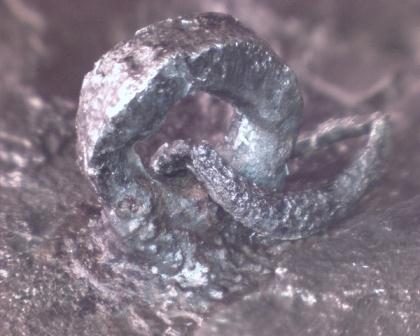
 Attachment: 136.38 KB Attachment: 136.38 KB
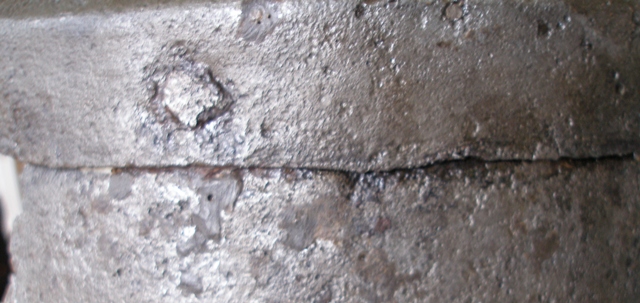
 Attachment: 101.32 KB Attachment: 101.32 KB
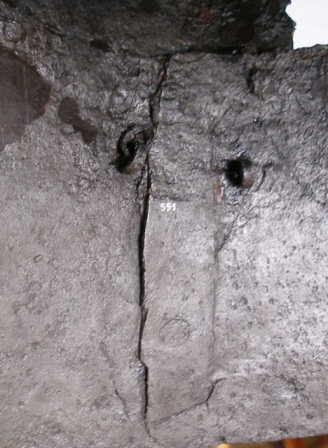
 Attachment: 198.39 KB Attachment: 198.39 KB
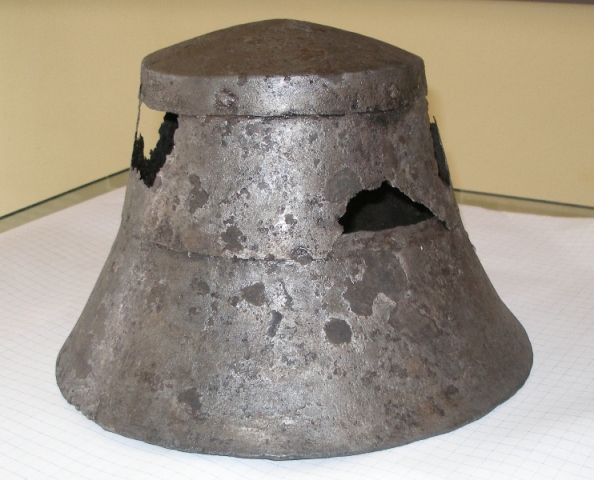
 Attachment: 74.27 KB Attachment: 74.27 KB
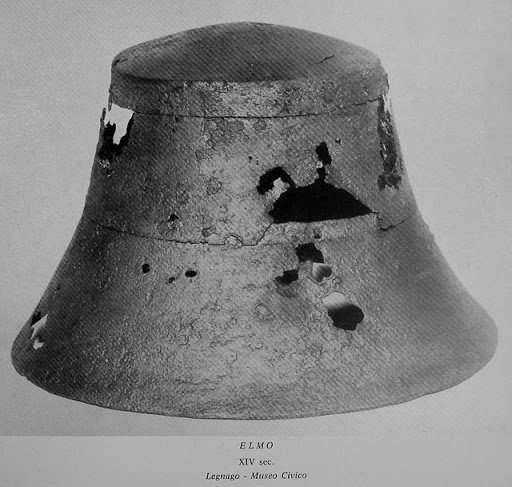
 Attachment: 178.85 KB Attachment: 178.85 KB
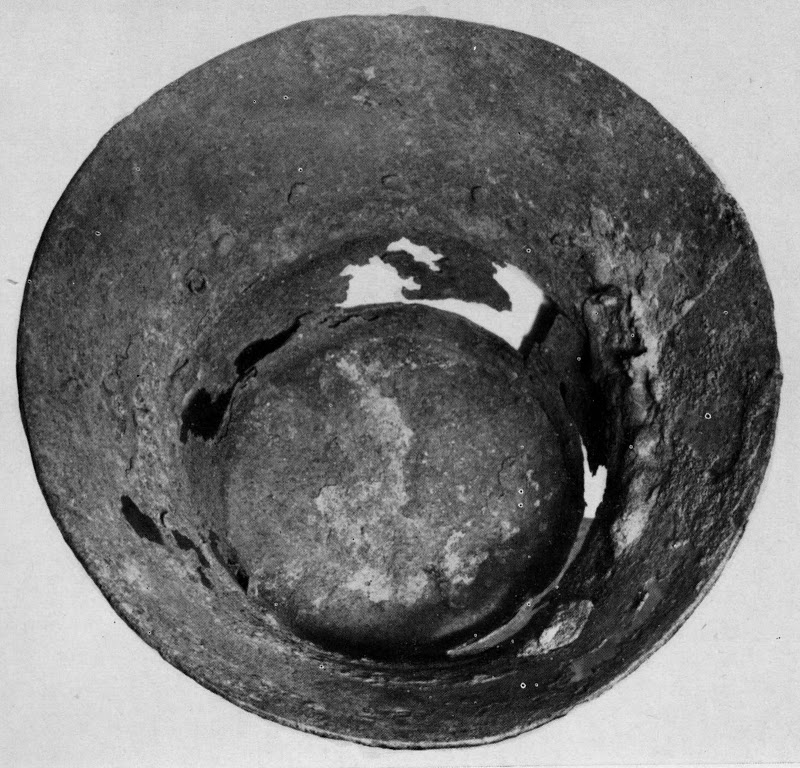
 Attachment: 179.1 KB Attachment: 179.1 KB
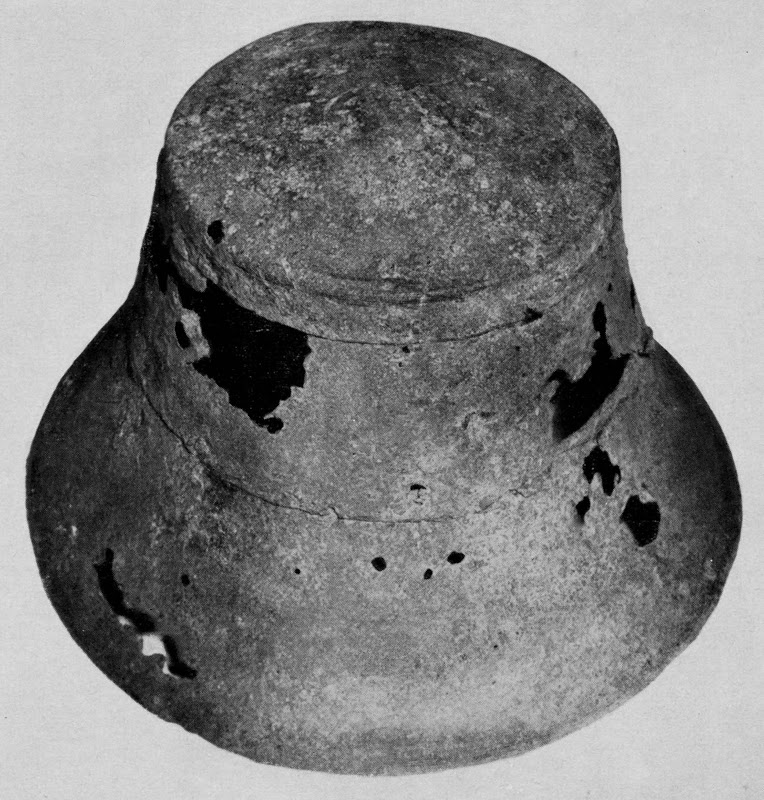
ferrum ferro acuitur et homo exacuit faciem amici sui
|
|
  |
 |
|
Gregory J. Liebau
Location: Dinuba, CA Joined: 27 Nov 2004
Posts: 669
|
 Posted: Sun 30 Dec, 2012 12:13 pm Post subject: Posted: Sun 30 Dec, 2012 12:13 pm Post subject: |
 |
|
Not much that can be added to Mart's assessment! I'd chime in and say that what's interesting (and rather helpful) is that most of the trends he's cited are rather recognizable throughout European art. For example, it's unlikely that there were many technical differences between a German helm in 1240 and a contemporary piece from England. Details changed, perhaps, and some of these can be distinguished from the mass of pictorial evidence... But for the most part have been obscured by the medium, in my opinion.
-Gregory
|
|
  |
 |
|
A Casalucci
|
 Posted: Sun 30 Dec, 2012 2:04 pm Post subject: Posted: Sun 30 Dec, 2012 2:04 pm Post subject: |
 |
|
Simply great, Mart. I think I've got enough proofs, samples to move forward, your "division" in decades is the clearest I found on the web. Thank you very much for your answers, I'll share these informations with my group. If anyone could say something more, or different, maybe basing on geographical localization, I'll be more than thankful, but I imagine this is more than I hoped.
Thank you again guys!
A.
|
|
  |
 |
Arek Przybylok

Location: Upper Silesia Joined: 16 Jan 2007
Posts: 112
|
 Posted: Sun 30 Dec, 2012 2:25 pm Post subject: Posted: Sun 30 Dec, 2012 2:25 pm Post subject: |
 |
|
I can recommend you Jacek Pierzak's " Helmy garnczkowe na ziemiach polskich na tle zachodnio europejskim" as really good book about great helmets. Unfrotunately, it is only in Polish. But there are many pictures in it and a big catalogue of those helmets.
I have one question.
Do you know any sources which content representations of great helmets with grill on its eyehole? Examples from around the middle of 13th century would be the best.
http://diebgasse.blogspot.com/
|
|
   |
 |
|
Mart Shearer
|
 Posted: Sun 30 Dec, 2012 3:30 pm Post subject: Posted: Sun 30 Dec, 2012 3:30 pm Post subject: |
 |
|
Something like this?

I'm not sure what that's meant to depict, but I recall Oxford's Bodleian has a similar image--so similar it may have been pounced from the same template. Bodley MS.264 shows vertical bars over the occularia of a sugarloaf, but that's mid 14th century.
ferrum ferro acuitur et homo exacuit faciem amici sui
|
|
  |
 |
|
|
You cannot post new topics in this forum
You cannot reply to topics in this forum
You cannot edit your posts in this forum
You cannot delete your posts in this forum
You cannot vote in polls in this forum
You cannot attach files in this forum
You can download files in this forum
|
All contents © Copyright 2003-2025 myArmoury.com — All rights reserved
Discussion forums powered by phpBB © The phpBB Group
Switch to the Basic Low-bandwidth Version of the forum
|

